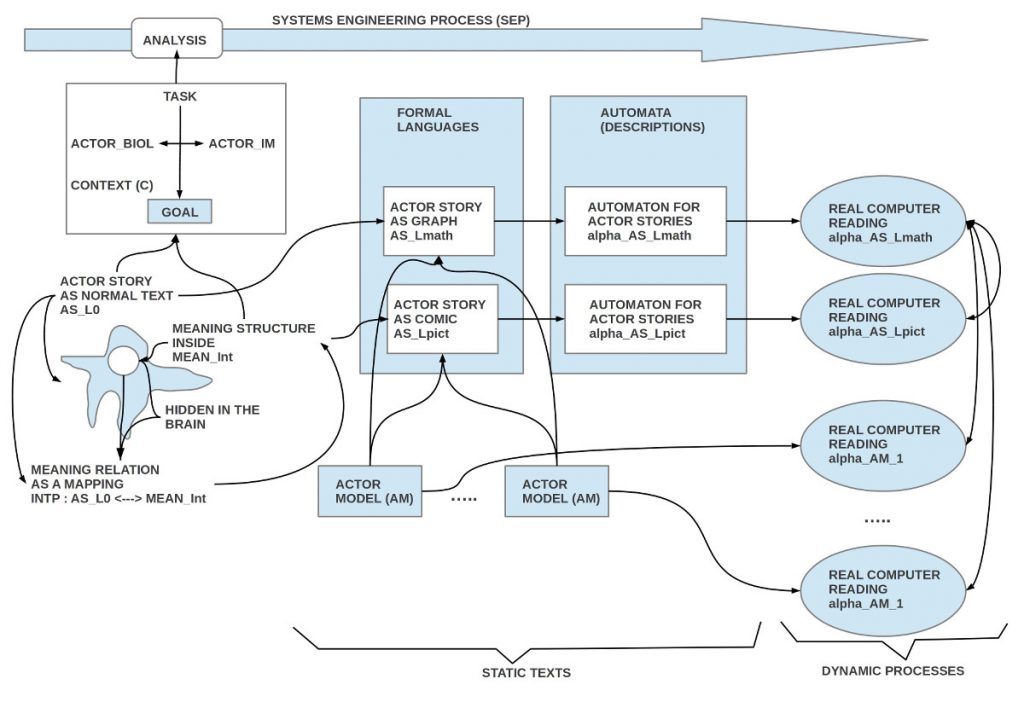eJournal: uffmm.org, ISSN 2567-6458
Email: info@uffmm.org
Author: Gerd Doeben-Henisch
Email: gerd@doeben-henisch.de
ATTENTION: The actual Version you will find HERE.
Update 26.June 2018 (Chapter AS-AM Summary)
Update 4.July 2018 (Chapter 4 Actor Model; improving the terminology of environments with actors, actors as input-output systems, basic and real interface, a first typology of input-output systems…)
Update 17.July 2018 (Preface, Introduction new)
Update 19.July 2018 (Introduction final paragraph!, new chapters!)
Update 20.July 2018 (Disentanglement of chapter ‘Simulation & Verification’ into two independent chapters; corrections in the chapter ‘Introduction’; corrections in chapter ‘AAI Analysis’; extracting ‘Simulation’ from chapter ‘Actor Story’ to new chapter ‘Simulation’; New chapter ‘Simulation’; Rewriting of chapter ‘Looking Forward’)
Update 22.July 2018 (Rewriting the beginning of the chapter ‘Actor Story (AS)’, not completed; converting chapter ‘AS+AM Summary’ to ‘AS and AM Philosophy’, not completed)
Update 23.July 2018 (Attaching a new chapter with a Case Study illustrating an actor story (AS). This case study is still unfinished. It is a case study of a real project!)
Update 7.August 2018 (Modifying chapter Actor Story, the introduction)
Update 8.August 2018 (Modifying chapter AS as Text, Comic, Graph; especially section about the textual mode and the pictorial mode; first sketch for a mapping from the textual mode into the pictorial mode)
Update 9.August 2018 (Modification of the section ‘Mathematical Actor Story (MAS) in chapter 4).
Update 11.August 2018 (Improving chapter 3 ‘Actor Story; nearly complete rewriting of chapter 4 ‘AS as text, comic, graph’.)
Update 12.August 2018 (Minor corrections in the chapters 3+4)
Update 13.August 2018 (I am still catched by the chapters 3+4. In chapter the cognitive structure of the actors has been further enhanced; in chapter 4 a complete example of a mathematical actor story could now been attached.)
Update 14.August 2018 (minor corrections to chapter 4 + 5; change-statements define for each state individual combinatorial spaces (a little bit like a quantum state); whether and how these spaces will be concretized/ realized depends completely from the participating actors)
Update 15.August 2018 (Canceled the appendix with the case study stub and replaced it with an overview for a supporting software tool which is needed for the real usage of this theory. At the moment it is open who will write the software.)
Update 2.October 2018 (Configuring the whole book now with 3 parts: I. Theory, II. Application, III. Software. Gerd has his focus on part I, Zeynep will focus on part II and ‘somebody’ will focus on part III (in the worst case we will — nevertheless — have a minimal version :-)). For a first quick overview about everything read the ‘Preface’ and the ‘Introduction’.
Update 4.November 2018 (Rewriting the Introduction (and some minor corrections in the Preface). The idea of the rewriting was to address all the topics which will be discussed in the book and pointing out to the logical connections between them. This induces some wrong links in the following chapters, which are not yet updated. Some chapters are yet completely missing. But to improve the clearness of the focus and the logical inter-dependencies helps to elaborate the missing texts a lot. Another change is the wording of the title. Until now it is difficult to find a title which is exactly matching the content. The new proposal shows the focus ‘AAI’ but lists the keywords of the main topics within AAA analysis because these topics are usually not necessarily associated with AAI.)
ACTOR-ACTOR INTERACTION [AAI]. An Actor Centered Approach to Problem Solving. Combining Engineering and Philosophy
by
GERD DOEBEN-HENISCH in cooperation with LOUWRENCE ERASMUS, ZEYNEP TUNCER
BACKGROUND INFORMATION 19.Dec.2018: Application domain ‘Communal Planning and e-Gaming’
BACKGROUND INFORMATION 24.Dec.2018: The AAI-paradigm and Quantum Logic
PRE-VIEW: NEW EXPANDED AAI THEORY 23.January 2019: Outline of the new expanded AAI Paradigm. Before re-writing the main text with these ideas the new advanced AAI theory will first be tested during the summer 2019 within a lecture with student teams as well as in several workshops outside the Frankfurt University of Applied Sciences with members of different institutions.

